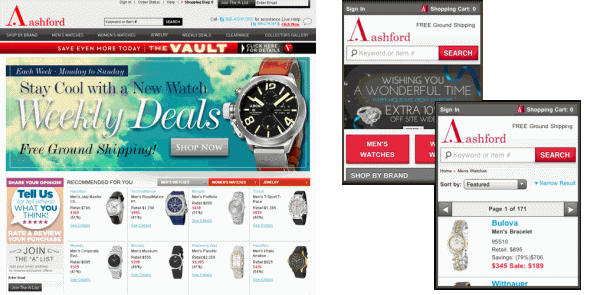A consistent cross-channel experience is a must-have for retailers today, but isn’t always easy to achieve. One of the biggest challenges is that the combination of two or more channels creates a lot of ways your shoppers can get lost, confused, or frustrated, which ultimately means that you lose the sale. Here are some tips that will help you deliver a cross-channel experience your customers will love:
1. Make your channels look similar.
This tip might seem really obvious, but you’d be surprised how many retailers don’t seem to get this: your branding needs to stay consistent across all your channels! Same colors, same general layout, same personality — you get the idea. Your customers are going to be confused if, for example, your ecommerce site and mobile site look completely different. Now, if your customers are confused, do you think they’re going to readily hand over their credit card numbers? The answer is no. To establish a strong sense of trustworthiness, make sure all your sales channels are consistently branded so that your customers know they’re in the right place.
A good example of consistent branding is demonstrated by online watch retailer Ashford.com. (Ecommerce site on the left, mobile version on the right.)
2. Integrate your channels.
Consumers have come to expect constant connectivity and interactivity between sales channels when shopping, and this cross-channel trend is only going to grow over time. Being able to offer integrated shopping experiences to your customers is not an option anymore – it’s a must!
I’m sure you’ve seen a brick-and-mortar store that is using QR codes. This is a perfect example of how two different sales channels can be integrated to work together. A traditional store might carry a specific product but can only display so much information due to physical restraints. By having a QR code on-site, customers are able to go on their mobile devices to find more detailed product information, images, and reviews that may lead to a purchase right there, in-store.
Another good example of this is in-store pickup. Give shoppers the option to purchase items online then pick them up in a physical location to avoid shipping costs.
3. Recognize a shopper across all devices.
Cross-device shopping is on the rise, meaning that many shoppers don’t complete a purchase on just one device. They’ll go from a laptop, to a smart phone, then finally to a tablet – all in the same purchase cycle! Encourage shoppers to log in to your site so that you can lay down the same cookie id and recognize them across all devices. This allows you to keep track of previously viewed products, purchase history, and to allow them to maintain their shopping cart so that they can easily checkout on any device. The easier it is for your customers to make a purchase, the better!
4. Allow shoppers to log in using their social media account.
Let’s face it, almost everyone online is logged in to their Facebook account (or some other kind of social media). Take advantage of this by allowing shoppers to log in to your ecommerce site with a social media account instead of having to enter all the fields manually — they’re much more likely to provide their email this way than by filling out a form. Make buying even easier by pre-filling their address information at checkout if the email has already been used before.
5. Keep content consistent across all channels.
One of the biggest challenges associated with multichannel retailing results from inconsistent content across channels. Inconsistent pricing, product information, images – this all has an extremely negative impact on customer experience. If two or more channels are being used together in a cross-channel function, they need to contain the same information, or you risk losing credibility with your customers.
A simple solution to this problem is to implement a product information management solution, where you are able to maintain and control all your product information from a central source. This ensures that all content across all your channels will be consistent, directly enabling a better cross-channel experience.
Do you have any more tips for creating a perfect cross-channel experience? Make sure to share them in the comment section below!
Learn more about product information management and how it solves today’s ecommerce initiatives in the white paper below.



Pingback: Best Ecommerce Articles – September and October | Multi-Commerce Connection